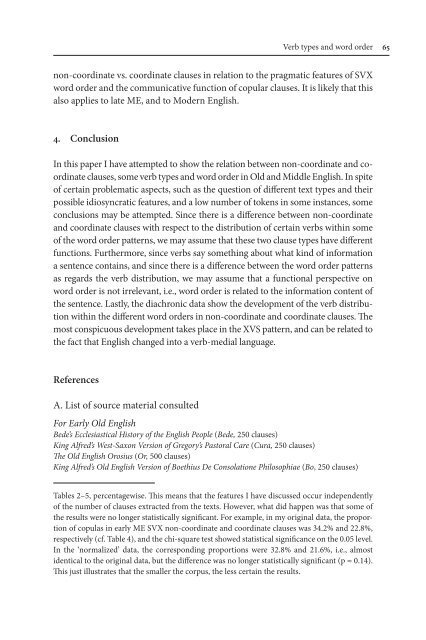Selected Papers from the Fourteenth International ... - STIBA Malang
Selected Papers from the Fourteenth International ... - STIBA Malang
Selected Papers from the Fourteenth International ... - STIBA Malang
You also want an ePaper? Increase the reach of your titles
YUMPU automatically turns print PDFs into web optimized ePapers that Google loves.
Verb types and word order 65<br />
non-coordinate vs. coordinate clauses in relation to <strong>the</strong> pragmatic features of SVX<br />
word order and <strong>the</strong> communicative function of copular clauses. It is likely that this<br />
also applies to late ME, and to Modern English.<br />
4. conclusion<br />
In this paper I have attempted to show <strong>the</strong> relation between non-coordinate and coordinate<br />
clauses, some verb types and word order in Old and Middle English. In spite<br />
of certain problematic aspects, such as <strong>the</strong> question of different text types and <strong>the</strong>ir<br />
possible idiosyncratic features, and a low number of tokens in some instances, some<br />
conclusions may be attempted. Since <strong>the</strong>re is a difference between non-coordinate<br />
and coordinate clauses with respect to <strong>the</strong> distribution of certain verbs within some<br />
of <strong>the</strong> word order patterns, we may assume that <strong>the</strong>se two clause types have different<br />
functions. Fur<strong>the</strong>rmore, since verbs say something about what kind of information<br />
a sentence contains, and since <strong>the</strong>re is a difference between <strong>the</strong> word order patterns<br />
as regards <strong>the</strong> verb distribution, we may assume that a functional perspective on<br />
word order is not irrelevant, i.e., word order is related to <strong>the</strong> information content of<br />
<strong>the</strong> sentence. Lastly, <strong>the</strong> diachronic data show <strong>the</strong> development of <strong>the</strong> verb distribution<br />
within <strong>the</strong> different word orders in non-coordinate and coordinate clauses. The<br />
most conspicuous development takes place in <strong>the</strong> XVS pattern, and can be related to<br />
<strong>the</strong> fact that English changed into a verb-medial language.<br />
References<br />
A. List of source material consulted<br />
For Early Old English<br />
Bede’s Ecclesiastical History of <strong>the</strong> English People (Bede, 250 clauses)<br />
King Alfred’s West-Saxon Version of Gregory’s Pastoral Care (Cura, 250 clauses)<br />
The Old English Orosius (Or, 500 clauses)<br />
King Alfred’s Old English Version of Boethius De Consolatione Philosophiae (Bo, 250 clauses)<br />
Tables 2–5, percentagewise. This means that <strong>the</strong> features I have discussed occur independently<br />
of <strong>the</strong> number of clauses extracted <strong>from</strong> <strong>the</strong> texts. However, what did happen was that some of<br />
<strong>the</strong> results were no longer statistically significant. For example, in my original data, <strong>the</strong> proportion<br />
of copulas in early ME SVX non-coordinate and coordinate clauses was 34.2% and 22.8%,<br />
respectively (cf. Table 4), and <strong>the</strong> chi-square test showed statistical significance on <strong>the</strong> 0.05 level.<br />
In <strong>the</strong> ‘normalized’ data, <strong>the</strong> corresponding proportions were 32.8% and 21.6%, i.e., almost<br />
identical to <strong>the</strong> original data, but <strong>the</strong> difference was no longer statistically significant (p ≈ 0.14).<br />
This just illustrates that <strong>the</strong> smaller <strong>the</strong> corpus, <strong>the</strong> less certain <strong>the</strong> results.










